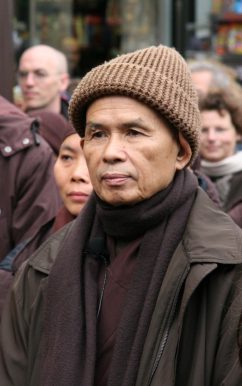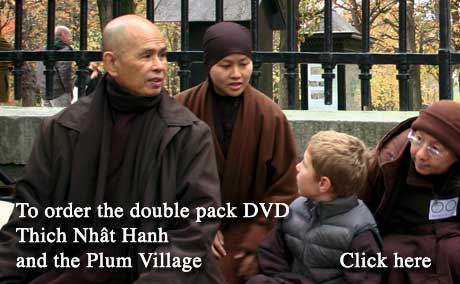Biography – Venerable Thich Nhat Hanh
HIS LIFE

Thich Nhat Hanh (pronounced “tik not hahn”) was born in central Vietnam in 1926 and joined the monkhood at the age of 16. In Saigon in the early 1960’s, he founded the School of Youth for Social Services (SYSS), a grass roots relief organization that rebuilt bombed villages, set up schools and medical centers, resettled homeless families, and organized agricultural cooperatives. Rallying some 10,000 student volunteers, the SYSS based its work on the Buddhist principles of non-violence and compassionate action. Despite government denunciation of his activity, Nhat Hanh also founded a Buddhist University, a publishing house, and an influential peace activist magazine in Vietnam.
Thich Nhat Hanh has been living in exile from his native Vietnam since the age of forty. In that year of 1966, he was banned by both the non-Communist and Communist governments for his role in undermining the violence he saw affecting his people. A Buddhist monk since the age of sixteen, Thay (“teacher”) as he is commonly known) earned a reputation as a respected writer, scholar, and leader. He championed a movement known as “engaged Buddhism,” which intertwined traditional meditative practices with active nonviolent civil disobedience.
This movement lay behind the establishment of the most influential center of Buddhist studies in Saigon, the An Quang Pagoda. He also set up relief organizations to rebuild destroyed villages, instituted the School of Youth for Social Service (a Peace Corps of sorts for Buddhist peace workers), founded a peace magazine, and urged world leaders to use nonviolence as a tool.
Although his struggle for cooperation meant he had to relinquish a homeland, it won him accolades around the world. When Thich Nhat Hanh left Vietnam, he embarked on a mission to spread Buddhist thought around the globe. In 1966, when Thay came to the United States for the first of many humanitarian visits, the territory was not completely new to him: he had experienced American culture before as a student at Princeton, and more recently as a professor at Columbia.
The Fellowship of Reconciliation and Cornell invited Thay to speak on behalf of Buddhist monks, and he offered an enlightened view on ways to end the Vietnam conflict. He spoke on college campuses, met with administration officials, and impressed social dignitaries. The following year, Nobel Peace Prize winner Dr. Martin Luther King, Jr., nominated Thich Nhat Hanh for the same honor. Hanh’s Buddhist delegation to the Paris peace talks resulted in accords between North Vietnam and the United States, but his pacifist efforts did not end with the war. He also helped organize rescue missions well into the 1970’s for Vietnamese trying to escape from political oppression. Even after the political stabilization of Vietnam, Thich Nhat Hanh has not been allowed to return home.
The government still sees him as a threat — ironic, when one considers the subjects of his teachings: respect for life, generosity, responsible sexual behavior, loving communication, and cultivation of a healthful life style.
He has written more than one-hundred titles, including books of prose, poetry, and prayers. Most of his works have been geared toward the Buddhist reader, yet his teachings appeal to a wide audience. For over the last two decades, Thich Nhat Hanh has visited the United States every other year; he draws more and more people with each tour, Christian, Jewish, atheist, and Zen Buddhist alike. His teachings and philosophy is not limited to preexistent religious structures, but speaks to the individual’s desire for wholeness and inner calm.
In 1993, he drew a crowd of some 1,200 people at the National Cathedral in Washington, DC, led a retreat of 500 people in upstate New York, and assembled 300 people in West Virginia. His popularity in the United States inspired the mayor of Berkeley, California, to name a day in his honor and the Mayor of New York City declared a Day of Reconciliation during his 1993 visit. Clearly, Thich Nhat Hanh is a human link with a prophetic past, a soft-spoken advocate of peace, Buddhist community, and the average American citizen.
Here is an inspiring poem by Thich Nhat Hanh. May it help to bring peace to all our hearts.
Kiss the Earth – By Thich Nhat Hanh
Walk and touch peace every moment.
Walk and touch happiness every moment.
Each step brings a fresh breeze.
Each step makes a flower bloom.
Kiss the Earth with your feet.
Bring the Earth your love and happiness.
The Earth will be safe
when we feel safe in ourselves.
BIBLIOGRAPHY
Selected Books – Thich Nhat Hanh
Living Buddha, Living Christ
Buddha and Christ, perhaps the two most pivotal figures in the history of humankind, each left behind a legacy that have shaped the lives of billions of people. Thich Nhat Hanh has been part of a decades-long dialogue between these two great contemplative traditions. In a lucid, meditative prose, Living Buddha, Living Christ explores the crossroads of compassion and holiness at which the two traditions meet, and reawakens our understanding of both.
Peace Is Every Step
In the lovely Peace Is Every Step, Thich Nhat Hanh shows us how to make positive use of the situations that usually anger us. Red lights and traffic jams, says Mr. Hanh, can be signals to call back our true selves. Peace lies all around us, he teaches, and can be brought back to mind with the simple act of consciously breathing, smiling, and quieting our minds.
Going Home
In Going Home: Jesus and Buddha as Brothers, Thich Nhat Hanh celebrates the life-affirming roots of two disparate spiritual traditions. While Living Buddha, Living Christ further opened the door to dialogue between Christianity and Buddhism, Going Home takes us on a journey into the practice. As Thich Nhat Hanh says, “We practice in such a way that Buddha is born every moment of our daily life, that Jesus Christ is born every moment of our daily life.”
No Death, No Fear
In No Death, No Fear, Thich Nhat Hanh explores traditional myths about how we live and die, and shows us how to come to terms with the true nature of our existence. If we realize that there is no death, we will be released from fear. With deep knowledge and expertise, Thich Nhat Hanh offers us in his book a fresh perspective on living a life unfettered by fear.
OTHER BOOKS :
– Thich Nhat Hanh : Essential Writings (Modern Spiritual Masters Series)
– Anger : Wisdom for Cooling the Flames
– Be Still and Know : Reflections from Living Buddha, Living Christ
– BeingPeace
– The Blooming of Lotus : Guided Meditation for Achieving the Miracle of Mindfulness
– Breathe! You Are Alive : Sutra on the Full Awareness of Breathing
– Cultivating the Mind of Love : The Practice of Looking Deeply in the Mahayana Buddhist Tradition
– The Diamond That Cuts Through Illusion : Commentaries on the Prajnaparamita Diamond Sutra
– For a Future to Be Possible : Commentaries on the Five Mindfulness Trainings
– The Heart of the Buddha’s Teaching
– The Heart of Understanding : Commentaries on the Prajnaparamita Heart Sutra
– The Miracle of Mindfulness: A Manual on Meditation
– Old Path, White Clouds : Walking in the Footsteps of the Buddha
– The Path of Emancipation: Talks from a 21-Day Mindfulness Retreatp
– The Present Moment
– Present Moment, Wonderful Moment : Mindfulness Verses for Daily Living
– The Sun My Heart : From Mindfulness to Insight Contemplation
– The Sutra on the Eight Realizations of the Great Beings
– Teaching son Love
– Thundering Silence : Sutra on Knowing the Better Way to Catch a Snake
– Touching Peace : Practicing the Art of Mindful Living
– Transformation at the Base: Fifty Verses on the Nature of Consciousness
– Zen Keys
– The Raft Is Not the Shore : Conversations Toward a Buddhist/Christian Awareness (with Daniel Berrigan and Robert Ellsberg)
– Mindful Living : A Collection of Teachings on Love, Mindfulness, and Meditation (audiotape set)
– Mindfulness and Psychotherapy (audiotape)





